Song Yang
System-integrated intrinsic static-dynamic pressure sensing enabled by charge excitation and 3D gradient engineering for autonomous robotic interaction
May 30, 2025Abstract:High-resolution pressure sensing that distinguishes static and dynamic inputs is vital for intelligent robotics but remains challenging for self-powered sensors. We present a self-powered intrinsic static-dynamic pressure sensor (iSD Sensor) that integrates charge excitation with a 3D gradient-engineered structure, achieving enhanced voltage outputs-over 25X for static and 15X for dynamic modes. The sensor exhibits multi-region sensitivities (up to 34.7 V/kPa static, 48.4 V/kPa dynamic), a low detection limit of 6.13 Pa, and rapid response/recovery times (83/43 ms). This design enables nuanced tactile perception and supports dual-mode robotic control: proportional actuation via static signals and fast triggering via dynamic inputs. Integrated into a wireless closed-loop system, the iSD Sensor enables precise functions such as finger bending, object grasping, and sign language output.
Spiking Neural Network for Intra-cortical Brain Signal Decoding
Apr 12, 2025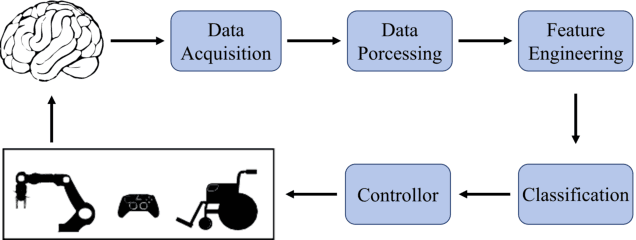
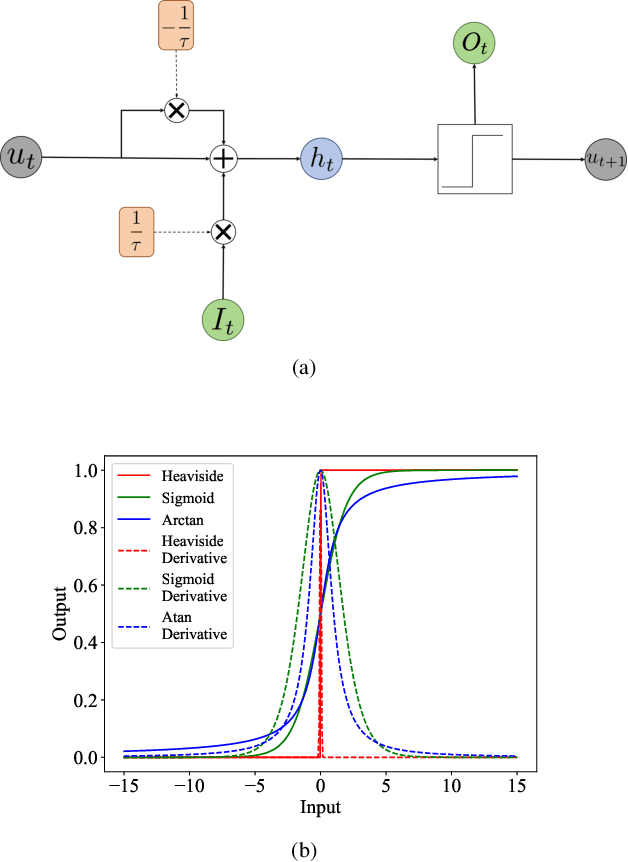
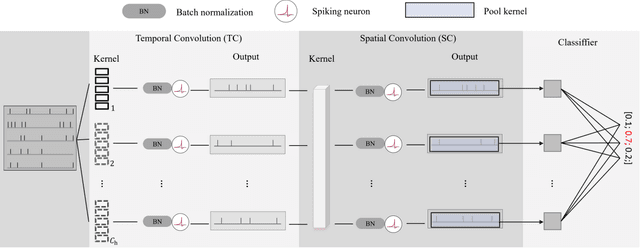
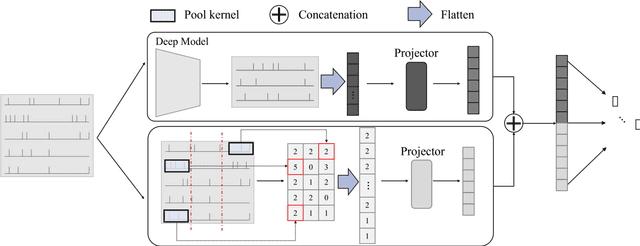
Abstract:Decoding brain signals accurately and efficiently is crucial for intra-cortical brain-computer interfaces. Traditional decoding approaches based on neural activity vector features suffer from low accuracy, whereas deep learning based approaches have high computational cost. To improve both the decoding accuracy and efficiency, this paper proposes a spiking neural network (SNN) for effective and energy-efficient intra-cortical brain signal decoding. We also propose a feature fusion approach, which integrates the manually extracted neural activity vector features with those extracted by a deep neural network, to further improve the decoding accuracy. Experiments in decoding motor-related intra-cortical brain signals of two rhesus macaques demonstrated that our SNN model achieved higher accuracy than traditional artificial neural networks; more importantly, it was tens or hundreds of times more efficient. The SNN model is very suitable for high precision and low power applications like intra-cortical brain-computer interfaces.
D3-Guard: Acoustic-based Drowsy Driving Detection Using Smartphones
Mar 30, 2025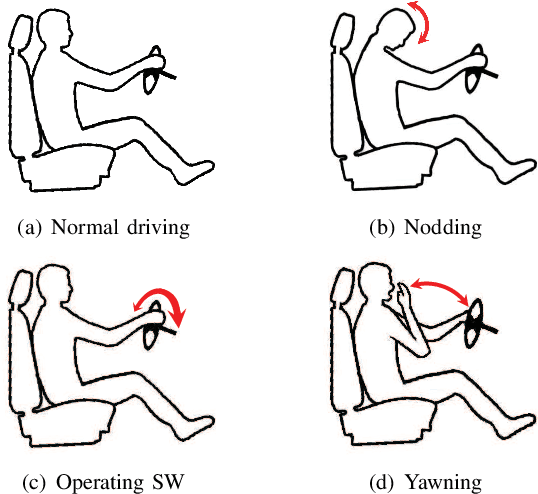
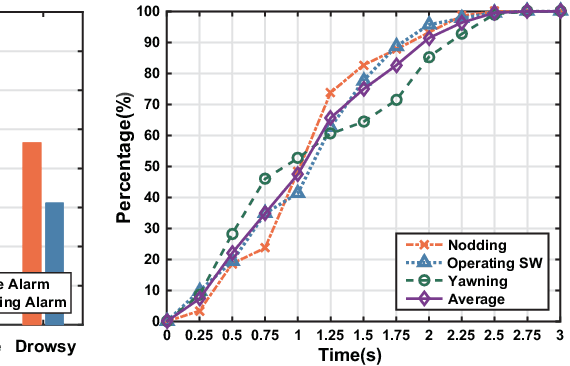


Abstract:Since the number of cars has grown rapidly in recent years, driving safety draws more and more public attention. Drowsy driving is one of the biggest threatens to driving safety. Therefore, a simple but robust system that can detect drowsy driving with commercial off-the-shelf devices (such as smartphones) is very necessary. With this motivation, we explore the feasibility of purely using acoustic sensors embedded in smartphones to detect drowsy driving. We first study characteristics of drowsy driving, and find some unique patterns of Doppler shift caused by three typical drowsy behaviors, i.e. nodding, yawning and operating steering wheel. We then validate our important findings through empirical analysis of the driving data collected from real driving environments. We further propose a real-time Drowsy Driving Detection system (D3-Guard) based on audio devices embedded in smartphones. In order to improve the performance of our system, we adopt an effective feature extraction method based on undersampling technique and FFT, and carefully design a high-accuracy detector based on LSTM networks for the early detection of drowsy driving. Through extensive experiments with 5 volunteer drivers in real driving environments, our system can distinguish drowsy driving actions with an average total accuracy of 93.31% in real-time. Over 80% drowsy driving actions can be detected within first 70% of action duration.
HearSmoking: Smoking Detection in Driving Environment via Acoustic Sensing on Smartphones
Mar 30, 2025



Abstract:Driving safety has drawn much public attention in recent years due to the fast-growing number of cars. Smoking is one of the threats to driving safety but is often ignored by drivers. Existing works on smoking detection either work in contact manner or need additional devices. This motivates us to explore the practicability of using smartphones to detect smoking events in driving environment. In this paper, we propose a cigarette smoking detection system, named HearSmoking, which only uses acoustic sensors on smartphones to improve driving safety. After investigating typical smoking habits of drivers, including hand movement and chest fluctuation, we design an acoustic signal to be emitted by the speaker and received by the microphone. We calculate Relative Correlation Coefficient of received signals to obtain movement patterns of hands and chest. The processed data is sent into a trained Convolutional Neural Network for classification of hand movement. We also design a method to detect respiration at the same time. To improve system performance, we further analyse the periodicity of the composite smoking motion. Through extensive experiments in real driving environments, HearSmoking detects smoking events with an average total accuracy of 93.44 percent in real-time.
Data Pricing for Graph Neural Networks without Pre-purchased Inspection
Feb 12, 2025



Abstract:Machine learning (ML) models have become essential tools in various scenarios. Their effectiveness, however, hinges on a substantial volume of data for satisfactory performance. Model marketplaces have thus emerged as crucial platforms bridging model consumers seeking ML solutions and data owners possessing valuable data. These marketplaces leverage model trading mechanisms to properly incentive data owners to contribute their data, and return a well performing ML model to the model consumers. However, existing model trading mechanisms often assume the data owners are willing to share their data before being paid, which is not reasonable in real world. Given that, we propose a novel mechanism, named Structural Importance based Model Trading (SIMT) mechanism, that assesses the data importance and compensates data owners accordingly without disclosing the data. Specifically, SIMT procures feature and label data from data owners according to their structural importance, and then trains a graph neural network for model consumers. Theoretically, SIMT ensures incentive compatible, individual rational and budget feasible. The experiments on five popular datasets validate that SIMT consistently outperforms vanilla baselines by up to $40\%$ in both MacroF1 and MicroF1.
ReARTeR: Retrieval-Augmented Reasoning with Trustworthy Process Rewarding
Jan 14, 2025Abstract:Retrieval-Augmented Generation (RAG) systems for Large Language Models (LLMs) hold promise in knowledge-intensive tasks but face limitations in complex multi-step reasoning. While recent methods have integrated RAG with chain-of-thought reasoning or test-time search using Process Reward Models (PRMs), these approaches encounter challenges such as a lack of explanations, bias in PRM training data, early-step bias in PRM scores, and insufficient post-training optimization of reasoning potential. To address these issues, we propose Retrieval-Augmented Reasoning through Trustworthy Process Rewarding (ReARTeR), a framework that enhances RAG systems' reasoning capabilities through post-training and test-time scaling. At test time, ReARTeR introduces Trustworthy Process Rewarding via a Process Reward Model for accurate scalar scoring and a Process Explanation Model (PEM) for generating natural language explanations, enabling step refinement. During post-training, it utilizes Monte Carlo Tree Search guided by Trustworthy Process Rewarding to collect high-quality step-level preference data, optimized through Iterative Preference Optimization. ReARTeR addresses three core challenges: (1) misalignment between PRM and PEM, tackled through off-policy preference learning; (2) bias in PRM training data, mitigated by balanced annotation methods and stronger annotations for challenging examples; and (3) early-step bias in PRM, resolved through a temporal-difference-based look-ahead search strategy. Experimental results on multi-step reasoning benchmarks demonstrate significant improvements, underscoring ReARTeR's potential to advance the reasoning capabilities of RAG systems.
Target-Prompt Online Graph Collaborative Learning for Temporal QoS Prediction
Aug 20, 2024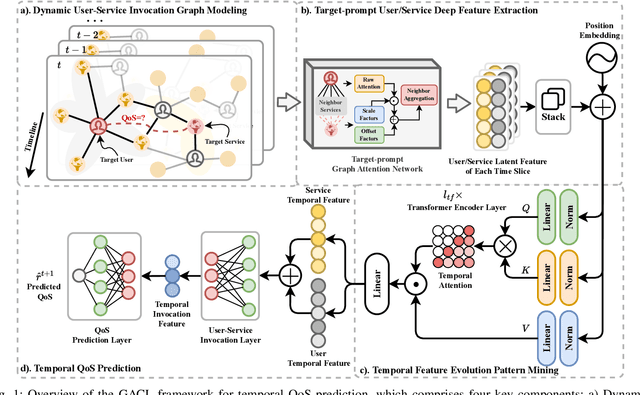
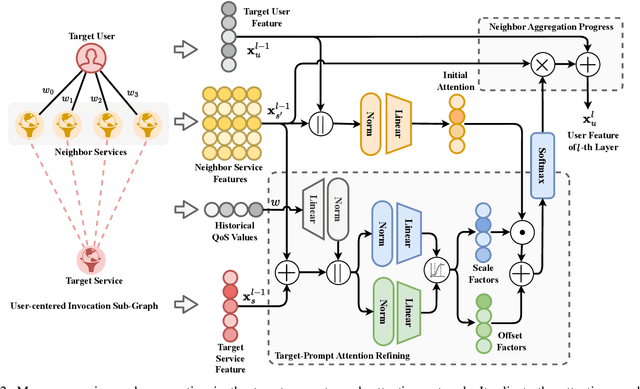

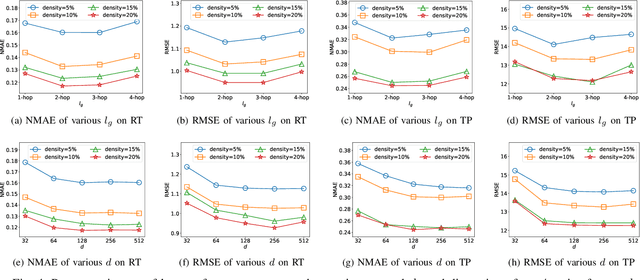
Abstract:In service-oriented architecture, accurately predicting the Quality of Service (QoS) is vital for maintaining reliability and enhancing user satisfaction. However, current methods often neglect high-order latent collaborative relationships and fail to dynamically adjust feature learning for specific user-service invocations, which are critical for precise feature extraction. Moreover, relying on RNNs to capture QoS evolution limits the ability to detect long-term trends due to challenges in managing long-range dependencies. To address these issues, we propose the Target-Prompt Online Graph Collaborative Learning (TOGCL) framework for temporal QoS prediction. It leverages a dynamic user-service invocation graph to comprehensively model historical interactions. Building on this graph, it develops a target-prompt graph attention network to extract online deep latent features of users and services at each time slice, considering implicit target-neighboring collaborative relationships and historical QoS values. Additionally, a multi-layer Transformer encoder is employed to uncover temporal feature evolution patterns, enhancing temporal QoS prediction. Extensive experiments on the WS-DREAM dataset demonstrate that TOGCL significantly outperforms state-of-the-art methods across multiple metrics, achieving improvements of up to 38.80\%. These results underscore the effectiveness of TOGCL for temporal QoS prediction.
MLS-Track: Multilevel Semantic Interaction in RMOT
Apr 18, 2024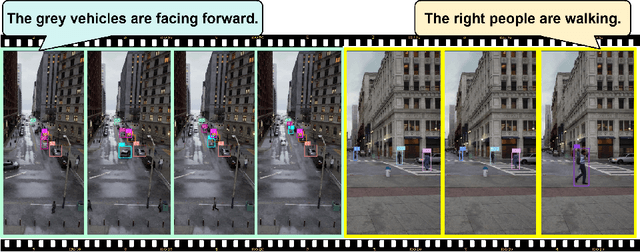

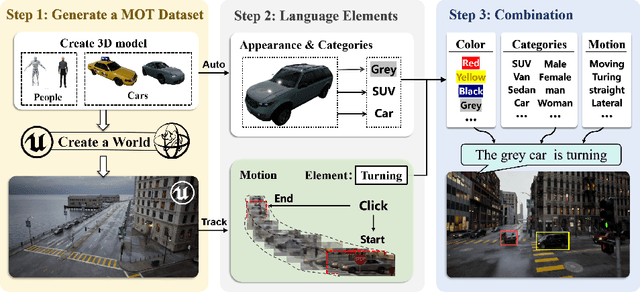
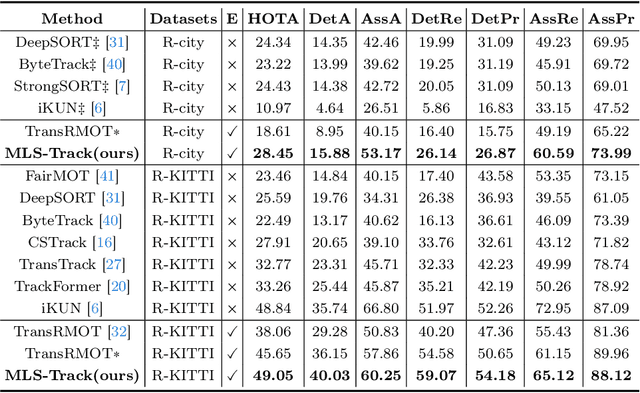
Abstract:The new trend in multi-object tracking task is to track objects of interest using natural language. However, the scarcity of paired prompt-instance data hinders its progress. To address this challenge, we propose a high-quality yet low-cost data generation method base on Unreal Engine 5 and construct a brand-new benchmark dataset, named Refer-UE-City, which primarily includes scenes from intersection surveillance videos, detailing the appearance and actions of people and vehicles. Specifically, it provides 14 videos with a total of 714 expressions, and is comparable in scale to the Refer-KITTI dataset. Additionally, we propose a multi-level semantic-guided multi-object framework called MLS-Track, where the interaction between the model and text is enhanced layer by layer through the introduction of Semantic Guidance Module (SGM) and Semantic Correlation Branch (SCB). Extensive experiments on Refer-UE-City and Refer-KITTI datasets demonstrate the effectiveness of our proposed framework and it achieves state-of-the-art performance. Code and datatsets will be available.
Joint Physical-Digital Facial Attack Detection Via Simulating Spoofing Clues
Apr 12, 2024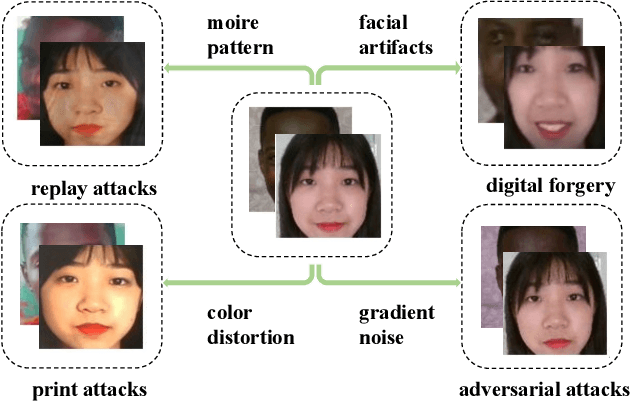
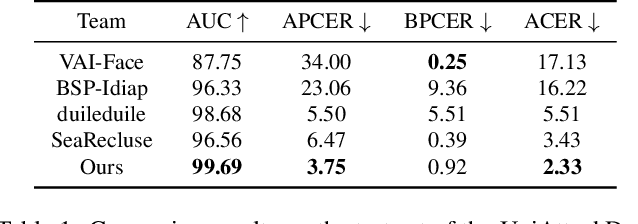
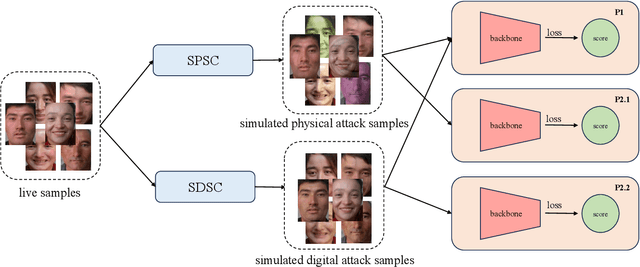
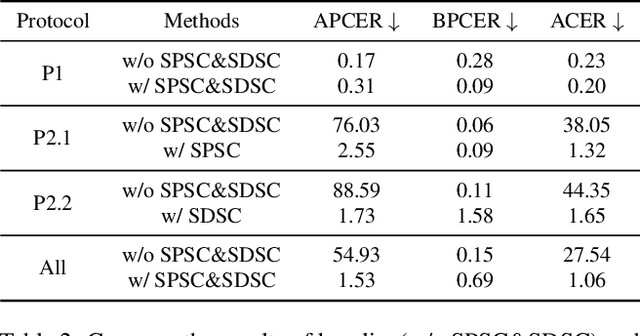
Abstract:Face recognition systems are frequently subjected to a variety of physical and digital attacks of different types. Previous methods have achieved satisfactory performance in scenarios that address physical attacks and digital attacks, respectively. However, few methods are considered to integrate a model that simultaneously addresses both physical and digital attacks, implying the necessity to develop and maintain multiple models. To jointly detect physical and digital attacks within a single model, we propose an innovative approach that can adapt to any network architecture. Our approach mainly contains two types of data augmentation, which we call Simulated Physical Spoofing Clues augmentation (SPSC) and Simulated Digital Spoofing Clues augmentation (SDSC). SPSC and SDSC augment live samples into simulated attack samples by simulating spoofing clues of physical and digital attacks, respectively, which significantly improve the capability of the model to detect "unseen" attack types. Extensive experiments show that SPSC and SDSC can achieve state-of-the-art generalization in Protocols 2.1 and 2.2 of the UniAttackData dataset, respectively. Our method won first place in "Unified Physical-Digital Face Attack Detection" of the 5th Face Anti-spoofing Challenge@CVPR2024. Our final submission obtains 3.75% APCER, 0.93% BPCER, and 2.34% ACER, respectively. Our code is available at https://github.com/Xianhua-He/cvpr2024-face-anti-spoofing-challenge.
Large Language Model Meets Graph Neural Network in Knowledge Distillation
Feb 09, 2024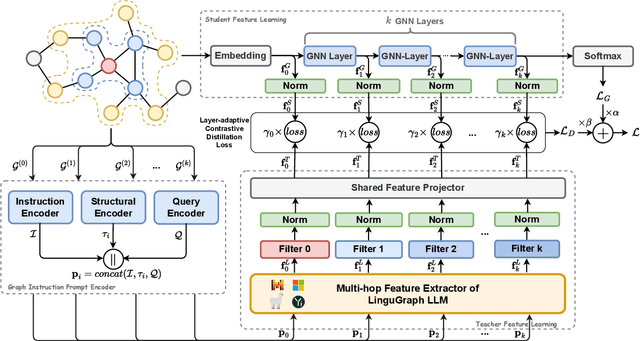

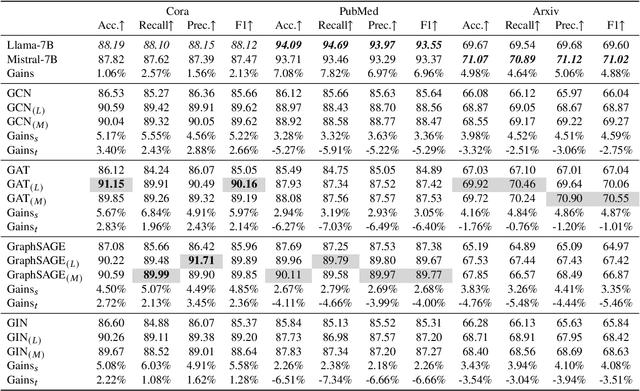
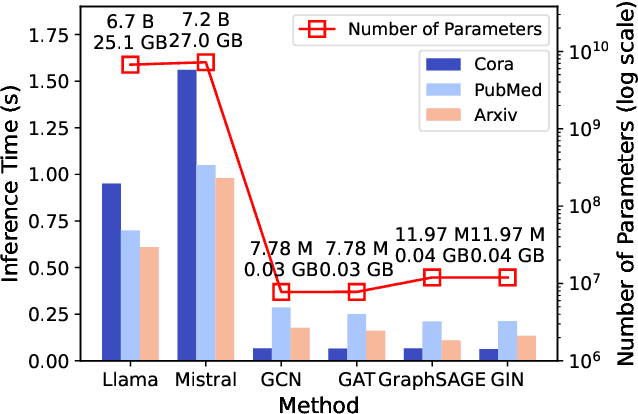
Abstract:Despite recent community revelations about the advancements and potential applications of Large Language Models (LLMs) in understanding Text-Attributed Graph (TAG), the deployment of LLMs for production is hindered by its high computational and storage requirements, as well as long latencies during model inference. Simultaneously, although traditional Graph Neural Networks (GNNs) are light weight and adept at learning structural features of graphs, their ability to grasp the complex semantics in TAG is somewhat constrained for real applications. To address these limitations, we concentrate on the downstream task of node classification in TAG and propose a novel graph knowledge distillation framework, termed Linguistic Graph Knowledge Distillation (LinguGKD), using LLMs as teacher models and GNNs as student models for knowledge distillation. It involves TAG-oriented instruction tuning of LLM on designed tailored prompts, followed by propagating knowledge and aligning the hierarchically learned node features from the teacher LLM to the student GNN in latent space, employing a layer-adaptive contrastive learning strategy. Through extensive experiments on a variety of LLM and GNN models and multiple benchmark datasets, the proposed LinguGKD significantly boosts the student GNN's predictive accuracy and convergence rate, without the need of extra data or model parameters. Compared to teacher LLM, distilled GNN achieves superior inference speed equipped with much fewer computing and storage demands, when surpassing the teacher LLM's classification accuracy on some of benchmark datasets.
 Add to Chrome
Add to Chrome Add to Firefox
Add to Firefox Add to Edge
Add to Edge